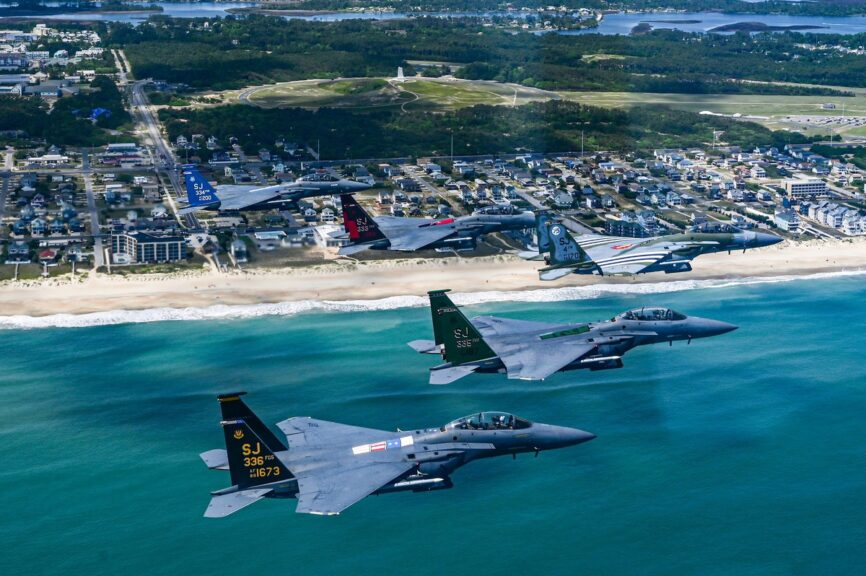Ah, yes. A perfect Outer Banks beach day. Not a cloud in the sky, and there’s just enough of a breeze from the southwest to keep the heat from being oppressive. The ocean water temperature is somewhere around 73 or 74 degrees—cool and refreshing.
One of the ubiquitous biplanes of the Outer Banks flies by, towing a banner for a local restaurant, flying from south to north.
Then the sound of jet engines can be heard . . . faintly at first, then louder, coming from the north. Looking out to sea, three jets stand out against the deep blue sky, holding formation.

Earlier in the day, a Coast Guard helicopter flew by, followed by a large four-engined aircraft with the distinctive red and white pattern of the USCG.
All of that air activity doesn’t disrupt the perfect day, but it does raise a question: where are they all coming from?
There is not much of a military presence on the Outer Banks—Coast Guard bases at Oregon Inlet and Hatteras being the exception. But just up the road in the Hampton Roads area of Virginia are some of the largest military bases in the United States.
The North Carolina Coast Guard Air Station Elizabeth City is the service’s largest air base and patrols as far away as Greenland and the Azores.
There are too many military bases in the Hampton Roads area to list, but any aircraft doing an Outer Banks flyby probably come from either Langley Air Force Base or Naval Station Norfolk.
The naval base is the largest single concentration of naval personnel in the U.S., although when the fleet is deployed the number on base is lower. There is an airfield at the station, and it is used extensively. Langley Air Force Base, it’s official name is Joint Base Langley-Eustis, serves the Air Force and US Army.
Langley AFB was established in 1916, and may be the oldest continually operating military airbase in the world.
It’s difficult to say where the aircraft are going or what they are doing as they fly by, but training exercises are probably a primary focus.
That wasn’t always the case. The Outer Banks played a unique role in military flight training in the past, bombing missions, to be specific.
During WWII, the land north of the Duck village was considered so desolate and removed from human habitation that it was used as a bombing range. That land is now where the Corps of Engineers Field Research Facility is located—or as it is better known, the Duck Research Pier.
Driving by the property, you will see signs warning of live ordinance, and they’re not kidding—there are bombs and explosives left over from WWII buried in the sand.
There is still an active bombing range in Dare County, the “Navy Dare Bombing Range.” Surrounded by Alligator River National Wildlife Refuge, the bombing range is very much in use.
The military aircraft that fly by could be any of a number of helicopters or airplanes.
The Coast Guard helicopter is probably a MH-60 Jayhawk, which specializes in ocean rescue. The bit four engine aircraft that is commonly spotted is a Hercules C-130 that’s been customized for Coast Guard use. Occasionally a Navy helicopter will also cruise by.
And the jets? If it’s Air Force, it’s probably the F-22 Raptor—the newest aircraft in the Air Force arsenal. If it’s Navy, probably an F-18 Super Hornet.
